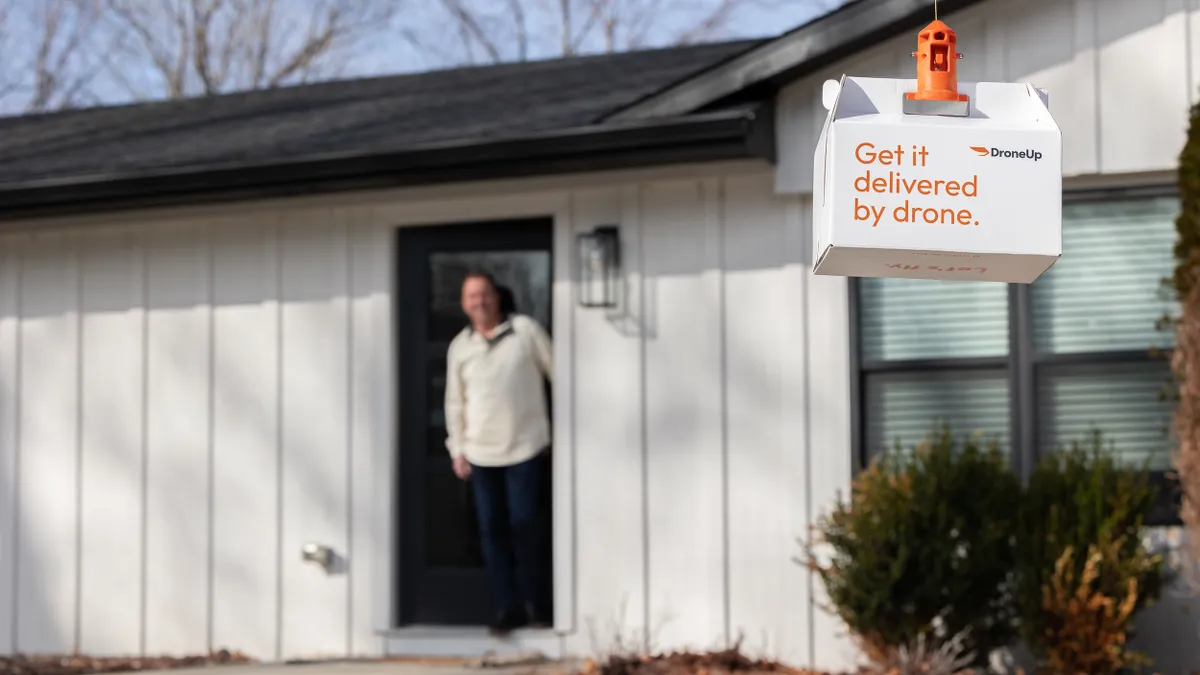More businesses are leveraging low-flying drones to handle last-mile delivery of small packages around the United States. Drones could “revolutionize many industries and city services,” according to the National League of Cities.

DroneUp began delivering COVID-19 test kits for Walmart during the pandemic, explained Tom Walker, the company’s founder and CEO. “It was so successful that Walmart then invested in our company, and we became a partner with them in drone delivery,” he said.
Walker also served for nearly 17 years in the U.S. Navy and as a White House advisor on technology innovation. Smart Cities Dive spoke with Walker to learn more about this growing field and how he sees the future of delivery.
Editor’s note: This interview has been edited for clarity and brevity.
SMART CITIES DIVE: For those who haven’t experienced it, what is drone delivery? For example, if I order something from Walmart, how does it get to my home?
TOM WALKER: The drone may not actually fly from the Walmart. It may [go to a] depot or go to Walmart [and] pick up the package. That's where the automated process kicks in. It lowers down, it loads the package, and then it'll take off, fly to the customer's home, deliver it and then fly back to the depot or fly to another pickup.
Can you describe the depot?
It fits in a parking space. It holds 30 packages. You can come and scan a barcode, and then you put the package in the door [and] walk away. A drone is deployed [and] lands on top. It loads through the top. The drone takes off and delivers [the package].
Why is this better than getting a delivery from a UPS or FedEx truck?
The average package that's delivered into neighborhoods every day weighs 8 pounds or less. In fact, most of those packages that are delivered into neighborhoods weigh 3 pounds, and 90% of those packages sit on a shelf within five miles of the home.
But how do we deliver it? We take multi-ton, carbon-emitting trucks, [and] we drive them 17 to 20 miles to distribution centers. We load them up with all these 3-pound packages, and then we drive through neighborhoods, clogging roads and clogging our air. So if you look at it from a cost standpoint, if you look at it from an environmental standpoint, if you look at it from a safety standpoint, if you add all those things together, that all equals one thing: With e-commerce going up 2% to 3% per year, it's simply not sustainable. We're talking about replacing it with a quieter, safer device.
DroneUp currently operates in almost three dozen communities. How do residents respond when you first start in a new location?
When we go into a new community, we meet with all the first responders. We go meet with the civic leagues. We bring the drone out [and] fly it for them. The biggest concerns most people have initially are privacy and noise. [Our drones] don't collect any video or photographs. We're never recording, and we make that point to them.
How high do the drones fly? Are they noisy?
We stay below 400 feet. Generally, we try to stay above 200 feet in transit, especially with our new drone that we're testing now. At 200 feet, you can't hear it at all. And at delivery altitude, which is about 100 feet, where we lower our package on the ground, it's about the same sound as your refrigerator.
The Federal Aviation Administration recently approved DroneUp to fly over populated areas and beyond the line of sight. How does that change what you can do?
It eliminates the need for visual observers [and] validates that we're operating in a reliable, safe and compliant manner. We can go to any customer now, we can carry their products, and we can carry them beyond visual line of sight.
How do you see the future for drone delivery?
We’ve still got some things to work out with the FAA. We're not in the metropolitan areas. It's very challenging, not to mention there's a much higher concentration of non-single family homes there. If you think about a drone delivering to your front porch, well, if you live in an apartment complex, a condo, a retirement facility [or] a campus, you don't have that.
We've also built delivery systems where you can take your phone [and] scan your barcode, and you can get your package right out of the [depot]. I believe that in the next 10 years, 80% of all packages will be delivered within 15 minutes by drone.












